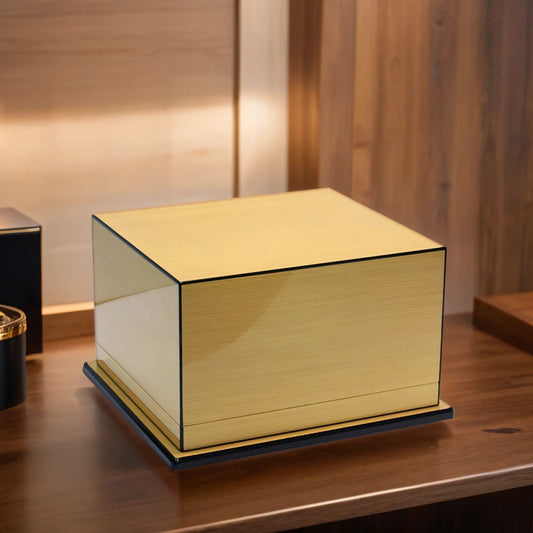
How to Cut a Cigar and Choose the Right Cut Type
Cutting a cigar seems simple until you realize how many ways you can mess it up. The wrong cut can ruin the draw, unravel the wrapper, or make you look like you brought a butter knife to a precision job. The right cut, on the other hand, unlocks the flavor and sets you up for an easy, smooth smoke.
This guide covers everything you need to know about cutting a cigar, from the basic how-to down to the different types of cigar cuts and how to match each one to your cigar shape. If you're going to slice the cap off your cigar, you might as well do it right.
How to Cut a Cigar the Right Way
Every premium cigar has a cap at the head. Your goal is to cut just enough of that cap to create a good opening without letting the wrapper unravel.
Use a proper cigar cutter, line it up about 1/16 to 1/8 of an inch from the end, and make one quick, confident snip. The goal is a clean cut that creates a smooth draw while keeping the cigar's structure intact. Cut too shallow and you will struggle to draw. Cut too deep and you risk peeling the wrapper or getting tobacco bits in your mouth.
Avoid twisting, tearing, or using a kitchen knife. This isn’t arts and crafts. Now let’s break down the most popular types of cigar cuts and when to use each.
| Cut Type | Best For | Draw Style | Risk Level |
|---|---|---|---|
| Straight Cut | Most cigars (Parejo) | Open, even | Moderate |
| V-Cut | Robusto, Toro | Focused, rich | Moderate |
| Punch Cut | Large ring gauge, flat caps | Tight, clean | Low |
| Shuriken | Advanced smokers only | Unique, high airflow | High |
Straight Cut
The straight cut is the most common and versatile. It’s a clean slice across the head of the cigar using a guillotine or scissors-style cutter.
Best For: Almost every cigar, especially parejos (straight-sided cigars)
What It Does: Creates a wide, even opening for easy draw
Pros: Simple, fast, works with most cigars
Cons: Easy to cut too deep if you’re not careful
Common Mistake: Snipping below the shoulder and causing the wrapper to unravel

V-Cut
Also known as a wedge cut, this method removes a V-shaped notch from the head of the cigar. It’s especially useful for smokers who want a concentrated draw and a more focused stream of smoke.
Best For: Robustos, toros, and other round caps
What It Does: Creates a deep channel in the cap, intensifying flavor delivery
Pros: Clean draw, adds a different mouthfeel
Cons: Not suitable for figurados or tapered heads
Common Mistake: Using a dull V-cutter and crushing the cigar head
Punch Cut
The punch cut uses a circular blade to remove a small plug from the cap, creating a smaller hole to draw through. It’s popular for smokers who prefer a tighter draw and less loose tobacco in the mouth.
Best For: Larger ring gauge cigars with flat caps
What It Does: Leaves the cap mostly intact and limits air intake
Pros: Great for on-the-go, minimal mess
Cons: Not ideal for torpedos or tapered heads
Common Mistake: Punching too hard and cracking the cap

Choosing the Right Cut for Your Cigar Shape
Not all cigars are built the same, and some cuts simply work better depending on the shape of your smoke.
Parejo (Straight-Sided Cigars)
These are your standard cigars with a round, flat head. They work with any of the cuts mentioned above. Straight cuts and V-cuts tend to offer the most reliable draw. Punch cuts work great too, especially on cigars with a bigger ring gauge.
Torpedo or Belicoso (Tapered Head)
For cigars with a pointed tip, use a straight cut and control how much of the cap you remove. You can experiment with deeper or shallower cuts to open up the draw to your liking. V-cuts and punches generally don’t work well here.
Figurado
These uniquely shaped cigars can require a little trial and error. A straight cut is usually the safest choice. Start small and take off a little more if needed. The key is to preserve the unusual shape while getting a proper draw.
Perfecto
Perfectos often have closed feet and tapered heads. Use a straight cut at the tip and expect a slightly firmer draw at first. As the cigar burns into its full ring gauge, the airflow improves. Don’t punch or V-cut these.

How Deep Should You Cut?
You only want to remove the very top of the cap. That’s usually about 1/8 inch. Cutting deeper risks slicing into the shoulder, which is where the wrapper starts to wrap around the body. That’s the point of no return. If you cut into the shoulder, you risk unraveling the whole thing.
If you’re not sure, start shallow. You can always cut a little more, but you can’t put it back.
Cutter Types and Maintenance
A good cutter makes a big difference. Here’s what to keep in mind.
Guillotine Cutter: The standard. Double-blade guillotines give the cleanest cut.
V-Cutter: Make sure it’s sharp. A dull V-cutter crushes more than it cuts.
Punch Cutter: Compact and easy, but only works well with flat caps.
Scissor Cutter: Elegant but requires steady hands.
Keep your cutter clean and sharp. Dull blades chew the cigar instead of slicing it. Plastic cutters are fine in a pinch, but if you’re smoking regularly, invest in something made of stainless steel. You’ll thank yourself.
Specialty Cuts Worth Knowing
These aren’t for everyday use, but they’re worth mentioning.
Shuriken Cut: Uses multiple tiny blades to create slits in the cap. It looks fancy but often overcomplicates things.
Cross Cut: A combo of two punch cuts forming a plus sign. Mostly just for fun.
Bite Cut: For emergencies only. And by emergencies, we mean you’re stranded without a cutter and using your teeth. Expect bits of tobacco and regret.

Final Thoughts
Cutting a cigar is more than just removing the cap. It’s a small but important part of the experience. Choose the right cut based on the cigar you’re smoking, use the right tool for the job, and take your time. You don’t need to get fancy, you just need to be precise.
A clean cut makes a good cigar even better. A bad cut makes even the best cigar taste like frustration. Start with the basics, match the cut to the shape, and before long, you’ll be slicing like a pro.
Frequently Asked Questions
What is the best way to cut a cigar for beginners?
A straight cut with a double guillotine cutter is the easiest and most forgiving method for new smokers. It works with most cigar shapes and provides a wide, even draw.
Is it better to use a V-cut or a punch cut?
It depends on your preference. A V-cut offers a richer draw with more airflow, while a punch cut delivers a tighter pull and reduces loose tobacco in your mouth.
Can I use scissors or a knife to cut a cigar?
Scissor cutters made specifically for cigars work well. Household scissors or knives often crush the cap and ruin the wrapper, so they should be avoided.
What happens if I cut too much off the cigar?
Cutting too far past the cap can cause the wrapper to unravel and the cigar to fall apart during smoking. Once the shoulder is cut, there’s no structural support holding the wrapper in place.
Can I recut a cigar if the first cut was bad?
Yes, but only if there’s enough cap left. A shallow or uneven cut can sometimes be fixed with a second snip. If you’ve already cut too deep or damaged the wrapper, recutting won’t help much.












